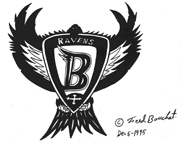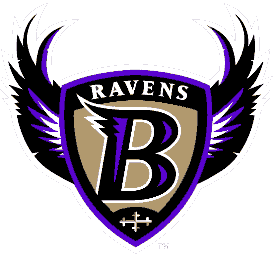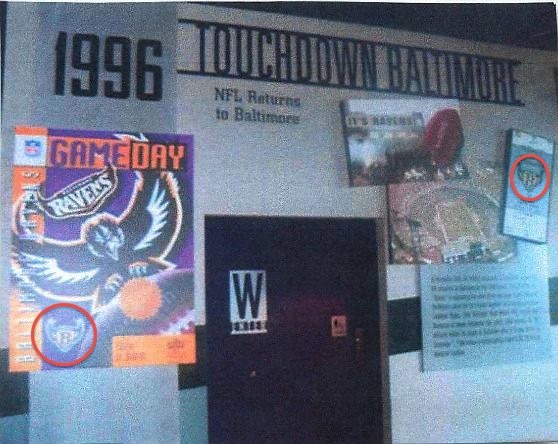A Case that Just Keeps Giving to Copyright Lawyers
It’s been a long time since our last edition of the fast-paced game that’s sweeping the nation, Is It Fair Use? Yes, I’ve been busy, but the real reason is that there just haven’t been any really fun fair use cases in a while. It may turn out that 2011 was just a banner year for fair use cases, what with Elf off the Shelf (twice), Green Day’s screaming icon and the Rasta-rip-off case. And who could possibly forget the “What What in the Butt”/South Park case, which piled weirdness upon weirdness? 2012? Eh, not so much.
Bouchat v. Baltimore Ravens is one of the most vigorously litigated copyright cases of all time. No fewer than seven published opinions have emanated from the case, including three published appellate opinions. I was a little surprised and delighted to find that it’s still going strong. What’s better is the most recent opinion involves not one but two issues of fair use, which went different ways. The opinion (which I’m not linking to now) provides handy insight into the sticky question of what is fair use.
Play part of two of this edition of Is it Fair Use!
Interlude: How the Browns Sort of Became the Ravens
The lawsuit has to do with the Baltimore Ravens* football team and one of its “old” logos. The Ravens aren’t that old a team, except that they sort of are. They used to be the Cleveland Browns, one of professional football’s most storied franchises. Cleveland (along with the San Francisco 49ers**) used to be in the All-American Football League and completely dominated the league. When that league folded, Cleveland (and San Francisco) were invited to join the National Football League, starting in 1950.
* I need to acknowledge that, yes, I live in Nashville, and yes, I root for the Tennessee Titans. Unlike certain Nashvilleans, I bear the Ravens no particular ill-will. Sometimes you lose games you should have won because your placekicker suddenly decides to drive his kicks low into the line, thereby losing your best chance at a Super Bowl. Actually, it hurts to write that. As for Ray Lewis, read Gregg Easterbrook’s revisionist take on how to judge the man since that fateful night in Atlanta.
** Mentioned here because they’re my childhood team not because of any relevance. I rooted for them when they were 2-14, the year they hired Bill Walsh.
The Browns proceeded immediately to dominate the NFL, winning the championship in their very first year. They also won championships in 1954 and 1955 and were runners up in 1951–53 and 1957. That’s six straight appearances (plus one more) and three championships! The Browns dominated the league with the forward pass, under the innovative schemes of Paul Brown (who would go on to found the Cincinnati Bengals). Its quarterback, Otto Graham—on everybody’s list of NFL’s greatest quarterbacks—put up numbers that would look impressive, even Brady-esque, today, but were out of this world in the 1950’s and 60’s.
Cleveland won NFL championships in 1950 (first year in the league) 1954, 1955 and 1964 (with Jim Brown), and then gave its fans nothing but heartbreak since—including what is probably the single most heartbreaking play in professional football history (Ernest Byner’s fumble against John Elway’s Denver Broncos, heartbreaking because Byner was single-handedly keeping the Browns in the game and was about strides away from winning the game when…*). They are one of the few teams never to appear in a Super Bowl. Because Cleveland hadn’t suffered enough, it was decreed that the Browns would move to a city that had already had ITS beloved football team ripped away: Baltimore (who lost their Colts to Indianapolis).
* Life isn’t fair sometimes.
That happened in 1996. Except the NFL wasn’t very happy about it. Somehow, the NFL convinced the Browns formerly-beloved-but-now-reviled owner Art Modell to leave all of the Browns’ intellectual property and records in Cleveland, though he could take the operating/business part of the team (you know, assets like players, staff, coaches) to Baltimore, as if it were an expansion team, only without the expansion part.
New Colors, New Logo
That meant that Modell’s team needed new team colors, new mascot, new nickname and new logos. Through a contest, the nickname “Ravens” was selected—in honor of Baltimore denizen Edgar Allen Poe. The team also settled on black and purple for its team colors.
* A football team nickname based on a literary reference? How cool is that?
Frederick Bouchat was a Baltimore security guard and amateur artist. Even before the Ravens adopted their nickname, he started making drawings of possible logos for a Ravens team. By chance, he got to meet the chairman of the Maryland Stadium Authority*, who was interested in the drawing and asked to have copies sent along. One of those drawings looked like this:

* Because someone wanted to include something about Bouchat’s fan-dom in an employee newsletter.
Not very long after that, the Ravens unveiled this as their new logo, to appear prominently on their uniforms (like their helmets), tickets, field, etc.:
At the time, people wondered what had gotten into the Ravens because the logo…. Well, it wasn’t very good. It looks like a shield that had sprouted wings. It’s both fussy and dull. It was made by professional designers at NFL Properties, yet, it looked… well, amateurish.
It turns out there was a reason for that: it had been designed by an amateur. Even after protracted litigation, it’s still not clear how it happened, but somehow, Bouchat’s drawing got passed along to the Ravens, then to NFL Properties. The nature and purpose of the drawing must have gotten more and more muddled at every link in the chain. Perhaps, “Hey, what do you think of this?” turned into “The boss wants us to consider this,” which turned into “Modell’s favorite nephew drew this and insists we base the logo on it.” And by the time it reached the designers, they were under the impression they were supposed to base the new Ravens logo on the drawing. They must have thought it looked amateurish, shrugged, then got to work because that’s what they got paid to do.
Not to let the designers off the aesthetic hook. If anything, their version is worse than Bouchat’s. Bouchat had a raven holding the shield, sort of like heraldry. It’s a bit awkward, particularly the way the bird’s head just sort of peeps over the top of the shield, but it’s better than a wingèd shield.
At first, the Ravens denied that they had ever seen the shield. When Bouchat sued*, they fought every inch of the way, and somehow kept a straight face all the way through (an under-appreciated lawyer skill). Never mind that the Ravens’ logo borrows nearly every feature from Bouchat’s drawing, or that a professional designer wouldn’t have produced such a clunky logo unless she was working off of Bouchat’s drawing. Nevertheless, it was up to Bouchat to prove access, and somehow he wasn’t able to prove direct access, only that he faxed the drawing to the stadium authority. That was good enough for two judges on the Fourth Circuit panel that decided the first appeal, but not good enough for a dissenter, who clearly didn’t believe anything Bouchat said and even intimated that Bouchat was the one who did the copying (based on a terrible misunderstanding of how copyright registrations work).
* Seeking $10 million in damages. Which gives you a sense of how the case was going to go.
In the end, Bouchat prevailed. Only not really. The jury found (and the Fourth Circuit affirmed) that the Ravens had, indeed, copied Bouchat’s design. Then the jury held (and the Fourth Circuit affirmed) that Bouchat would get no money. It wasn’t that he wasn’t damaged, but that he couldn’t come up with a reasonable way to measure damages. The Ravens made lots of money, but Bouchat didn’t prove which damages were attributable to the use of the logo.*
* Another example of life isn’t always fair? If so, then Bouchat got into the old Browns’ spirit very well.
Remember statutory damages? This is kind of why we have them. Why didn’t Bouchat get statutory damages? He knew enough to “write © 1995” on his sketch, but not enough to know that he should REGISTER his drawing! By the time he did, it was too late: no statutory damages if you don’t register before the infringement or within three months of publication. Sad, really.
Having lost on damages, Bouchat sued again, this time seeking an injunction. I really can’t imagine why. The Ravens stopped using the logo, and probably would have without the legal proceedings, because eventually, people would have realized what a big mistake the old logo was.
New Uses, Old Logo
Like most, if not all, NFL teams, the Ravens have a little museum in their stadium. It’s dedicated to the history of football in Baltimore, not just of the Ravens’ history, which is a good idea because otherwise it’d be a little pathetic. One of the displays discusses the Ravens’ 1996 arrival in Baltimore (and doubles as a women’s restroom, apparently). It shows a blown-up picture of a ticket, on which the old logo can be seen:
The Ravens also have a kind of constant slide-show going on inside the stadium showing “significant events of Ravens’ history.” This includes pictures of early Ravens’ draft choices, wearing the old Ravens’ uniforms, with the old Ravens’ logo. There are also photographs through out the stadium, showing things like Vinny Testaverde scoring the Ravens’ first touchdown ever. Of course, he’s wearing a Baltimore Ravens uniform, and of course it has the old logo on it.
The Ravens, naturally enough, say these uses are fair uses. Well, are they? Again, check out the fair-use factors.
Before you answer, consider this decision in the same case from 2010 from the Fourth Circuit, in which Bouchat’s injunction was partially affirmed. In that case, Bouchat complained about the Ravens’ continuing use of the old logo in highlight films. Film of the Ravens’ early years inevitably shows the old logo because it’s on the players’ helmets, and on the field. The court enjoined those highlight films, mostly because it concluded that they were commercial products, not historical records. (And also somehow they displaced Bouchat’s market for the old logo. Really?)
Have you made your mind, yet? If so, click here and see if you’re right!




Excellent, well-written blog post. Enjoyed learning about the Ravens’ history as I will be pulling for them in the Super Bowl. One minor grammatical observation: “supposed base” should read “supposed to base.” Again, well-done and thanks for having shared it in LinkedIn groups.
Thanks! Did you guess correctly? (We use the honor system here on Is it Fair Use?). I’ve fixed the typo, so thanks for pointing that out.